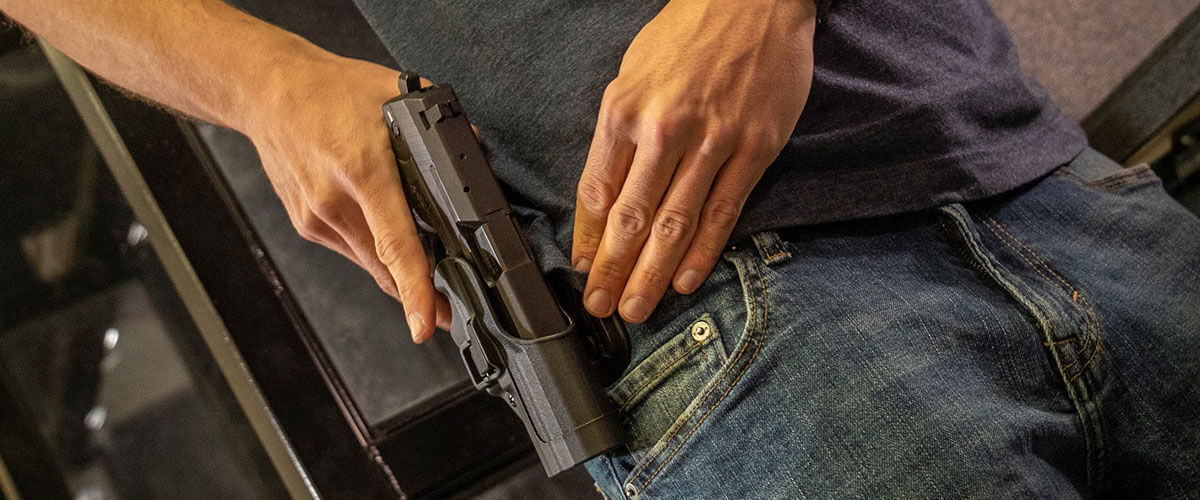Gear Saves Lives
By Jace Bauserman

Having the right concealed carry firearm is important. It has to fit you. You have to be comfortable with it. But the firearm you carry is only half the equation. The other half is your gear—your holster, mags, speed loaders and more. According to former Marine and current permit to carry instructor, George Walker, the second half of the concealed carry equation gets overlooked.
Firearm First
In addition to his military background, Walker has amassed more than 18 years of service in law enforcement. During that time, he’s served as a drug task force investigator, K9 handler and is the leader of his department’s SWAT team. That experience has taught him a lot, but one standout has been the importance of finding the gun that fits you best. He recommends renting some guns and going to the range. His biggest tip: Don’t over-gun. He sees too many people carrying handguns that are too big and create too much recoil.
“You can go light on the caliber,” he says. “You want a gun you can control. You want a gun that allows you to keep good form and have proper trigger control. At the shot, you don’t want a lot of recoil. Too much recoil will pull you off target.”
Don’t Skimp
Walker says that although the concealed carry crowd generally doesn’t pinch pennies when it comes to firearms or ammo, they often try to save some cash in the gear they choose.
“This is a big mistake,” he says. “You find the right concealed carry firearm but then skimp on your holster. You’re carrying concealed so you can protect yourself and others. If you have a bulky, flimsy nylon holster with a strap, how can you perfect your draw? How can you access your firearm quickly? You can’t.”
What about chest holsters? Walker admits they look cool and movies enhance their appeal, but chest rigs aren’t practical for concealed carry. They result in a lot of muzzle sweep when the gun is drawn and before acquiring the target. This is a safety issue. Plus, if you decide to re-holster, you have to take your eyes off your target, which makes you vulnerable.
So, he recommends an outside-the-waistband or inside-the-waistband holster. If you go inside-the-waistband, you must decide if you’re going to carry at a 9 o’clock (left-handed shooter) or 3 o’clock (right-handed shooter) or go appendix carry where you place the holster about halfway between the pant pocket and waistband button. You need to invest time experimenting and learning your draw—it will tell you where you’re most comfortable and what holster works best for you.
“An inside-the-waistband leather holster should have a metal band inside the mouth so it will not collapse when you draw. Finding the right holster can get expensive. You’re going to have to do your research and likely buy a few holsters before you find the one that’s right for you. Talk to other concealed-carry people. Ask your instructor. See what people are recommending. Find a holster that is comfortable for you. The last thing you want is a holster that digs into your hip or causes you a level of discomfort. Blackhawk has an online tool that helps with holster selection, and they make a great holster.”
Other Considerations
Whether you’re carrying inside- or outside-the-waistband, your choice of belt is also important. Walker says the last thing you want is a thin leather belt that causes the pants to sag. You’re carrying concealed for a reason. You don’t want anyone to know you have a weapon on you. The right belt with the right design and thickness is critical—they’re pricey but worth the investment.
While Walker notes heavier leather gun belts have their place, he likes a double-thick scuba webbing belt. The design supports his pants, holster and mag carriers.
Mag carriers are another piece of the gear puzzle. Many people want extra magazines. While there are holsters that have mag carriers built-in, most are a separate accessory item that goes on the belt. Again, where to carry mag carriers is a personal choice. You need to try the carriers in different locations on the belt and find carriers that allow for quick access.
“You need to be ready to spend some money,” Walker says. “This gear is an investment in your personal safety. You want the best. There is an inherent difference between a holster that is $30 and one that is $130. The same holds true for belts, purses and mag carriers. Do your research and do your testing. Choose the gear that fits you best and fills you with confidence.”